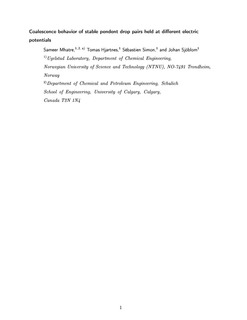| dc.contributor.author | Mhatre, Sameer | |
| dc.contributor.author | Hjartnes, Tomas | |
| dc.contributor.author | Simon, Sebastien Charles | |
| dc.contributor.author | Sjøblom, Johan | |
| dc.date.accessioned | 2020-02-19T09:20:55Z | |
| dc.date.available | 2020-02-19T09:20:55Z | |
| dc.date.created | 2020-02-16T16:29:21Z | |
| dc.date.issued | 2020 | |
| dc.identifier.issn | 0743-7463 | |
| dc.identifier.uri | http://hdl.handle.net/11250/2642477 | |
| dc.description.abstract | In this work, we studied the electrocoalescence behavior of stable pendent drop pairs and compared the results with clean drops, where the interface is void of surface-active compounds. The drop phase was brine and the drop–oil interface was stabilized by aging into asphaltene and demulsifier solutions. The experiments involving asphaltene-laden drops required the bulk phase to be clear for visualization of the drops, which is realized by a procedure to replace the asphaltene-containing dark bulk phase by a pure solvent mixture. The narrowly spaced pendent drops, maintained at different electric potentials, acquired net surface charge of opposite polarity, which led to the Coulombic attraction in the drop pair. After the application of voltage, a drop pair was observed to remain at a standstill, attracted, or coalesced depending on the interdrop separation, drop size, and potential difference. We systematically investigated the influence of different surface-active compounds on interfacial stabilization and electrostatic drop–drop attraction and coalescence behavior. Interestingly, the experimental data showed that a drop pair coalesces at a lower potential (ΔVcrit) when the drop–oil interface is populated with the surface-active molecules. Similarly, the minimum voltage (ΔVm) needed to induce attraction between two stable drops and the degree of the attraction are different than those of the clean drops. Furthermore, the demulsifier-laden drops exhibited dissimilar attraction, coalescence, and noncoalescence characteristics to the drops stabilized in asphaltene solutions. Our analysis suggested that the asphaltenes and the commercial demulsifiers differently influenced the drops’ response to the applied electric potential. The contrasting coalescence nature of the stable drops could be attributed to a complex interplay between hydrodynamics, electrostatics, and interfacial reorganization of the molecules and charges. | nb_NO |
| dc.language.iso | eng | nb_NO |
| dc.publisher | American Chemical Society | nb_NO |
| dc.relation.uri | https://pubs.acs.org/doi/10.1021/acs.langmuir.9b03554 | |
| dc.title | Coalescence Behavior of Stable Pendent Drop Pairs Held at Different Electric Potentials | nb_NO |
| dc.type | Journal article | nb_NO |
| dc.type | Peer reviewed | nb_NO |
| dc.description.version | acceptedVersion | nb_NO |
| dc.source.journal | Langmuir | nb_NO |
| dc.identifier.doi | https://doi.org/10.1021/acs.langmuir.9b03554 | |
| dc.identifier.cristin | 1794488 | |
| dc.relation.project | Norges forskningsråd: 255174 | nb_NO |
| dc.description.localcode | Locked until 1.2.2021 due to copyright restrictions.This document is the Accepted Manuscript version of a Published Work that appeared in final form in [Langmuir], copyright © American Chemical Society after peer review and technical editing by the publisher. To access the final edited and published work see https://doi.org/10.1021/acs.langmuir.9b03554 | nb_NO |
| cristin.unitcode | 194,66,30,0 | |
| cristin.unitname | Institutt for kjemisk prosessteknologi | |
| cristin.ispublished | true | |
| cristin.fulltext | original | |
| cristin.fulltext | postprint | |
| cristin.fulltext | preprint | |
| cristin.qualitycode | 2 | |
